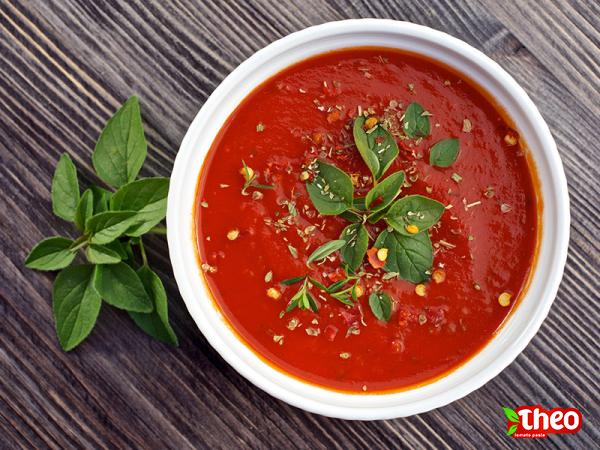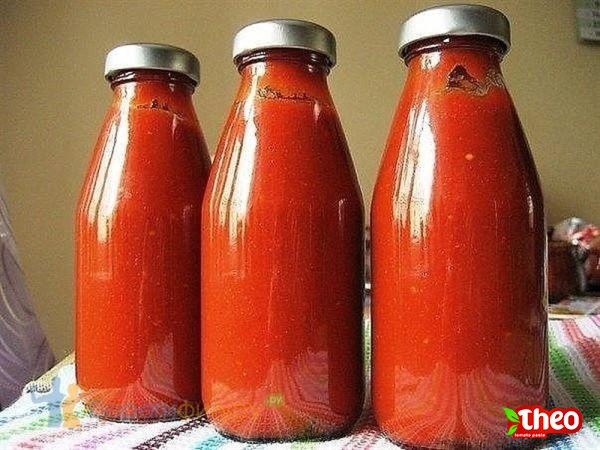Understanding the Similarities and Differences Introduction: Tomato products are widely used in various culinary applications, with tomato paste and tomato sauce being two popular options. Often used interchangeably, it is necessary to understand the similarities and differences between tomato paste and tomato sauce to make informed decisions while cooking or buying these products. In this article, we will delve into the characteristics, uses, and common misconceptions about tomato paste and tomato sauce, ultimately clarifying their equivalency and the circumstances in which they can be substituted. Characteristics of Tomato Paste: Tomato paste is made by cooking tomatoes for an extended period to reduce them into a concentrated form. Its intense tomato flavor is a result of the evaporation of moisture and concentration of natural sugars and acids present in tomatoes. Tomato paste typically has a thick consistency, a deep red color, and a velvety smooth texture. It is available in cans, tubes, and sometimes in small sachets, making it convenient for storage and long-term use. Common Uses of Tomato Paste: Tomato paste is a highly versatile ingredient used in a wide range of dishes. Its concentrated nature and rich flavor make it suitable for enhancing the taste and color of various recipes. Some common uses of tomato paste include: 1. Pasta Sauces: Tomato paste is a fundamental component of several pasta sauces, such as Bolognese, arrabbiata, and marinara. Its concentrated flavor contributes to the depth and intensity of these sauces. 2. Soups and stews: Tomato paste adds a robust tomato presence to soups and stews, making them more flavorful. It is a key ingredient in classic recipes like tomato soup and beef stew. 3. Pizza Sauce: Tomato paste is a primary ingredient in pizza sauce, providing the necessary flavor and texture to create the iconic taste associated with this popular dish. 4. Marinades and Condiments: Tomato paste is often used as a base for marinades, creating a tangy and savory flavor profile. It can also be transformed into homemade ketchup or barbecue sauce by combining it with other ingredients like vinegar, sugar, and spices.

tomato paste
 Characteristics of Tomato Sauce: Tomato sauce, also known as tomato puree or passata, differs from tomato paste in terms of texture, consistency, and flavor. It is made by removing the seeds and skin from tomatoes and then cooking them down into a smooth, thin liquid. Tomato sauce typically has a thinner consistency compared to tomato paste and a vibrant red color. It is commonly packaged in cans, jars, or tetra packs for easy storage and ready-to-use convenience. Common Uses of Tomato Sauce: Tomato sauce is a staple in numerous cuisines around the world and makes for a versatile ingredient in a variety of dishes. Some common uses of tomato sauce include: 1. Bases for Pasta Sauces: Tomato sauce serves as the foundation for many pasta sauces, such as marinara sauce and putanesca sauce. Its thinner consistency allows it to coat pasta evenly while still delivering a robust tomato flavor. 2. Pizzas and Flatbreads: Tomato sauce is the primary topping for pizzas and flatbreads, providing the essential flavor and moisture that complements other ingredients. 3. Curries and Stews: Tomato sauce is frequently used in curries and stews to add a tangy and mildly sweet flavor. It helps balance the richness of spices and tenderizes meat, creating a harmonious taste profile. 4. Soups and Gravies: Tomato sauce is often incorporated into soups and gravies to lend a subtle tomato flavor and add richness. In dishes like tomato bisque or creamy tomato soup, the sauce forms the base ingredient. Misconceptions and Equivalency: There can be confusion surrounding the equivalency of tomato paste and tomato sauce, leading to misconceptions about substituting one for the other. While both tomato paste and tomato sauce share a tomato base, their concentrated nature and dilution levels differentiate them. However, under certain circumstances, tomato paste and tomato sauce can be used interchangeably with certain considerations: 1. Flavor Intensity: Tomato paste has a stronger and more concentrated flavor compared to tomato sauce. To achieve a similar taste when substituting tomato sauce, additional reduction or the addition of other flavor-enhancing ingredients may be required. 2. Consistency and Texture: Tomato paste is much thicker than tomato sauce, which may affect the overall texture of a dish. If using tomato sauce as a substitute for tomato paste, it may be necessary to thicken the sauce with ingredients like cornstarch or simmer it for longer to obtain a desired consistency.
Characteristics of Tomato Sauce: Tomato sauce, also known as tomato puree or passata, differs from tomato paste in terms of texture, consistency, and flavor. It is made by removing the seeds and skin from tomatoes and then cooking them down into a smooth, thin liquid. Tomato sauce typically has a thinner consistency compared to tomato paste and a vibrant red color. It is commonly packaged in cans, jars, or tetra packs for easy storage and ready-to-use convenience. Common Uses of Tomato Sauce: Tomato sauce is a staple in numerous cuisines around the world and makes for a versatile ingredient in a variety of dishes. Some common uses of tomato sauce include: 1. Bases for Pasta Sauces: Tomato sauce serves as the foundation for many pasta sauces, such as marinara sauce and putanesca sauce. Its thinner consistency allows it to coat pasta evenly while still delivering a robust tomato flavor. 2. Pizzas and Flatbreads: Tomato sauce is the primary topping for pizzas and flatbreads, providing the essential flavor and moisture that complements other ingredients. 3. Curries and Stews: Tomato sauce is frequently used in curries and stews to add a tangy and mildly sweet flavor. It helps balance the richness of spices and tenderizes meat, creating a harmonious taste profile. 4. Soups and Gravies: Tomato sauce is often incorporated into soups and gravies to lend a subtle tomato flavor and add richness. In dishes like tomato bisque or creamy tomato soup, the sauce forms the base ingredient. Misconceptions and Equivalency: There can be confusion surrounding the equivalency of tomato paste and tomato sauce, leading to misconceptions about substituting one for the other. While both tomato paste and tomato sauce share a tomato base, their concentrated nature and dilution levels differentiate them. However, under certain circumstances, tomato paste and tomato sauce can be used interchangeably with certain considerations: 1. Flavor Intensity: Tomato paste has a stronger and more concentrated flavor compared to tomato sauce. To achieve a similar taste when substituting tomato sauce, additional reduction or the addition of other flavor-enhancing ingredients may be required. 2. Consistency and Texture: Tomato paste is much thicker than tomato sauce, which may affect the overall texture of a dish. If using tomato sauce as a substitute for tomato paste, it may be necessary to thicken the sauce with ingredients like cornstarch or simmer it for longer to obtain a desired consistency.
Specifications of tomato paste
 3. Cooking Time: Tomato paste has been cooked down longer than tomato sauce, resulting in a more intense flavor. When substituting tomato sauce for tomato paste, adjustments to cooking times and methods may be necessary to prevent altering the dish’s taste, texture, or appearance significantly. Conclusion: While tomato paste and tomato sauce have similarities in terms of their tomato base, they are distinct in flavor, texture, and consistency. Tomato paste is rich, concentrated, and thick, lending depth and intensity to dishes, while tomato sauce is smoother, thinner, and more commonly used as a base ingredient. Although they are not entirely equal, tomato paste and tomato sauce can be substituted for each other with certain considerations and adjustments to achieve satisfactory results in a variety of recipes. Understanding these differences enables cooks to make informed choices and experiment in the kitchen while successfully harnessing the flavors and textures these tomato products offer.Title: Tomato Paste vs. Tomato Sauce: Understanding the Similarities and Differences Introduction: Tomato products are widely used in various culinary applications, with tomato paste and tomato sauce being two popular options. Often used interchangeably, it is necessary to understand the similarities and differences between tomato paste and tomato sauce to make informed decisions while cooking or buying these products. In this article, we will delve into the characteristics, uses, and common misconceptions about tomato paste and tomato sauce, ultimately clarifying their equivalency and the circumstances in which they can be substituted. Characteristics and Uses: 1. Tomato Paste: Tomato paste is a highly concentrated tomato product with a thick consistency and deep red color. Due to its reduction process, tomato paste has an intense tomato flavor, making it a popular choice for enhancing the taste and color of various dishes, including pasta sauces, soups, stews, pizza sauce, and marinades. Its versatility and long shelf life in cans, tubes, or sachets make it convenient for storage and long-term use. 2. Tomato Sauce: Tomato sauce, also known as tomato puree or passata, is made by cooking down tomatoes into a smooth, thin liquid after removing the seeds and skin. With a vibrant red color and a thinner consistency compared to tomato paste, tomato sauce serves as the foundation for many pasta sauces, such as marinara and puttanesca. It is also commonly used in pizzas, curries, stews, soups, and gravies to add a tangy and mildly sweet flavor to the dishes.
3. Cooking Time: Tomato paste has been cooked down longer than tomato sauce, resulting in a more intense flavor. When substituting tomato sauce for tomato paste, adjustments to cooking times and methods may be necessary to prevent altering the dish’s taste, texture, or appearance significantly. Conclusion: While tomato paste and tomato sauce have similarities in terms of their tomato base, they are distinct in flavor, texture, and consistency. Tomato paste is rich, concentrated, and thick, lending depth and intensity to dishes, while tomato sauce is smoother, thinner, and more commonly used as a base ingredient. Although they are not entirely equal, tomato paste and tomato sauce can be substituted for each other with certain considerations and adjustments to achieve satisfactory results in a variety of recipes. Understanding these differences enables cooks to make informed choices and experiment in the kitchen while successfully harnessing the flavors and textures these tomato products offer.Title: Tomato Paste vs. Tomato Sauce: Understanding the Similarities and Differences Introduction: Tomato products are widely used in various culinary applications, with tomato paste and tomato sauce being two popular options. Often used interchangeably, it is necessary to understand the similarities and differences between tomato paste and tomato sauce to make informed decisions while cooking or buying these products. In this article, we will delve into the characteristics, uses, and common misconceptions about tomato paste and tomato sauce, ultimately clarifying their equivalency and the circumstances in which they can be substituted. Characteristics and Uses: 1. Tomato Paste: Tomato paste is a highly concentrated tomato product with a thick consistency and deep red color. Due to its reduction process, tomato paste has an intense tomato flavor, making it a popular choice for enhancing the taste and color of various dishes, including pasta sauces, soups, stews, pizza sauce, and marinades. Its versatility and long shelf life in cans, tubes, or sachets make it convenient for storage and long-term use. 2. Tomato Sauce: Tomato sauce, also known as tomato puree or passata, is made by cooking down tomatoes into a smooth, thin liquid after removing the seeds and skin. With a vibrant red color and a thinner consistency compared to tomato paste, tomato sauce serves as the foundation for many pasta sauces, such as marinara and puttanesca. It is also commonly used in pizzas, curries, stews, soups, and gravies to add a tangy and mildly sweet flavor to the dishes.
buy tomato paste
 Misconceptions and Equivalency: 1. Flavor Intensity: Tomato paste has a stronger and more concentrated flavor compared to tomato sauce. When substituting tomato sauce for tomato paste in a recipe, it is necessary to consider the flavor difference and adjust accordingly. Additional reduction or the addition of other flavor-enhancing ingredients may be required to achieve a similar taste. 2. Consistency and Texture: The thick consistency of tomato paste can significantly impact the overall texture of a dish. If substituting tomato sauce for tomato paste, it may be necessary to thicken the sauce with ingredients like cornstarch or simmer it for longer to obtain the desired consistency and texture. 3. Cooking Time: Tomato paste has been cooked down longer than tomato sauce, resulting in a more intense flavor. When substituting tomato sauce for tomato paste, adjustments to cooking times and methods may be necessary to prevent altering the dish’s taste, texture, or appearance significantly. Longer cooking times may be needed to concentrate the flavors of the sauce. Substituting Tomato Paste and Tomato Sauce: 1. Tomatoes + Water: When a recipe calls for tomato sauce but only tomato paste is available, the paste can be diluted with an appropriate amount of water to achieve a similar consistency and taste. Typically, this can be done by combining one part tomato paste with one part water, adjusting the amounts as needed. 2. Tomato Sauce Reduction: On the other hand, if a recipe calls for tomato paste but only tomato sauce is available, the sauce can be simmered and reduced to intensify its flavor and thicken its consistency. Simmer the sauce on low heat until the desired thickness is reached, as excess liquid evaporates. 3. Flavor Enhancement: When substituting tomato sauce for tomato paste, it may be necessary to enhance the flavor with additional ingredients. This can include ingredients like dried herbs, garlic, onion, or vinegar to achieve a more robust taste similar to the concentrated flavor of tomato paste. 4. Considerations for Textured Dishes: In dishes where the texture of tomato paste plays a crucial role, such as meatloaf or braised dishes, substituting tomato sauce may result in a less dense texture. In such cases, breadcrumbs or other binding agents can be added to compensate for the difference in texture. 5. Color Adjustment: Tomato paste contributes to the deep red color of dishes. When substituting tomato sauce, the color may appear lighter. To adjust the color, a small amount of tomato paste or a natural food coloring agent can be added to the sauce. Conclusion: Tomato paste and tomato sauce both play significant roles in enhancing the flavor and texture of various dishes. While they have distinct characteristics and uses, their equivalency allows for substitution in specific circumstances. Understanding the differences between tomato paste and tomato sauce enables cooks to make informed choices and experiment with these versatile tomato products. By considering flavor intensity, consistency, cooking time, and making necessary adjustments, cooks can successfully substitute tomato paste for tomato sauce, and vice versa, in their culinary endeavors, without compromising the overall quality of the dish.
Misconceptions and Equivalency: 1. Flavor Intensity: Tomato paste has a stronger and more concentrated flavor compared to tomato sauce. When substituting tomato sauce for tomato paste in a recipe, it is necessary to consider the flavor difference and adjust accordingly. Additional reduction or the addition of other flavor-enhancing ingredients may be required to achieve a similar taste. 2. Consistency and Texture: The thick consistency of tomato paste can significantly impact the overall texture of a dish. If substituting tomato sauce for tomato paste, it may be necessary to thicken the sauce with ingredients like cornstarch or simmer it for longer to obtain the desired consistency and texture. 3. Cooking Time: Tomato paste has been cooked down longer than tomato sauce, resulting in a more intense flavor. When substituting tomato sauce for tomato paste, adjustments to cooking times and methods may be necessary to prevent altering the dish’s taste, texture, or appearance significantly. Longer cooking times may be needed to concentrate the flavors of the sauce. Substituting Tomato Paste and Tomato Sauce: 1. Tomatoes + Water: When a recipe calls for tomato sauce but only tomato paste is available, the paste can be diluted with an appropriate amount of water to achieve a similar consistency and taste. Typically, this can be done by combining one part tomato paste with one part water, adjusting the amounts as needed. 2. Tomato Sauce Reduction: On the other hand, if a recipe calls for tomato paste but only tomato sauce is available, the sauce can be simmered and reduced to intensify its flavor and thicken its consistency. Simmer the sauce on low heat until the desired thickness is reached, as excess liquid evaporates. 3. Flavor Enhancement: When substituting tomato sauce for tomato paste, it may be necessary to enhance the flavor with additional ingredients. This can include ingredients like dried herbs, garlic, onion, or vinegar to achieve a more robust taste similar to the concentrated flavor of tomato paste. 4. Considerations for Textured Dishes: In dishes where the texture of tomato paste plays a crucial role, such as meatloaf or braised dishes, substituting tomato sauce may result in a less dense texture. In such cases, breadcrumbs or other binding agents can be added to compensate for the difference in texture. 5. Color Adjustment: Tomato paste contributes to the deep red color of dishes. When substituting tomato sauce, the color may appear lighter. To adjust the color, a small amount of tomato paste or a natural food coloring agent can be added to the sauce. Conclusion: Tomato paste and tomato sauce both play significant roles in enhancing the flavor and texture of various dishes. While they have distinct characteristics and uses, their equivalency allows for substitution in specific circumstances. Understanding the differences between tomato paste and tomato sauce enables cooks to make informed choices and experiment with these versatile tomato products. By considering flavor intensity, consistency, cooking time, and making necessary adjustments, cooks can successfully substitute tomato paste for tomato sauce, and vice versa, in their culinary endeavors, without compromising the overall quality of the dish.




